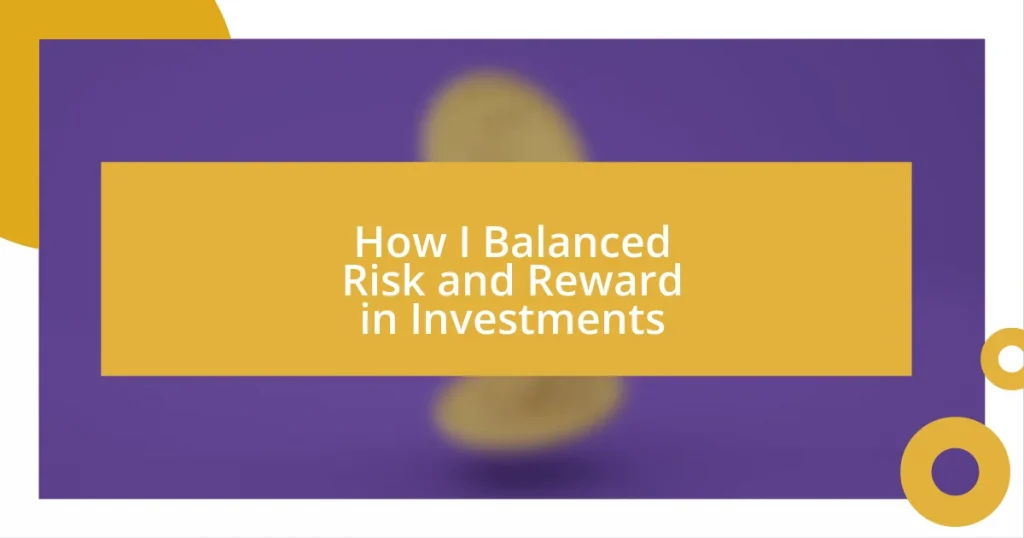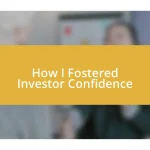Key takeaways:
- Understanding personal risk tolerance is crucial and can evolve over time due to life changes.
- Diversification and regular portfolio reviews are essential strategies for mitigating investment risks.
- Learning from past experiences, including losses, fosters a disciplined and informed investment approach.

Identifying Your Risk Tolerance
Identifying your risk tolerance is like mapping out your emotional landscape. I remember the first time I looked at my investment portfolio after a market downturn; my heart raced, and I immediately began to question my decisions. That experience taught me that understanding your own emotional reaction to risk is vital in determining how much uncertainty you can handle.
When considering risk, it’s essential to reflect on your personal financial goals and current situation. Ask yourself: What am I really comfortable with? For instance, I discovered that while I was drawn to the thrill of higher-risk investments, my lifestyle and responsibilities made me yearn for stability. This realization allowed me to balance my portfolio better and align it with my true comfort level.
In my journey, I’ve found that life circumstances can shift your risk tolerance significantly. After starting a family, my priorities changed, prompting a reassessment of my investments. This reassessment highlighted how crucial it is to periodically check in with your risk tolerance; it’s not a static measure but rather a dynamic part of your financial landscape that can evolve over time.

Strategies for Mitigating Investment Risks
When it comes to mitigating investment risks, diversification is a cornerstone strategy. I recall my early days as an investor when I put most of my funds into a single tech stock. It was exhilarating until it plummeted; that experience taught me a valuable lesson. Now, I spread my investments across various asset classes, including bonds, real estate, and international equities. This way, if one investment falters, the others can help cushion the blow.
To further manage risk, consider these effective strategies:
- Asset Allocation: Determine the right mix of stocks, bonds, and cash to suit your risk tolerance and goals.
- Regular Portfolio Review: Schedule consistent evaluations of your investments to ensure they align with your current situation.
- Limit Orders: Use limit orders to control the price at which you buy or sell, minimizing unexpected losses.
- Stay Informed: Educate yourself about market trends to make better decisions, avoiding knee-jerk reactions.
- Invest in Quality: Focus on established companies with strong fundamentals rather than chasing the latest trend.
I’ve found that keeping a level head is crucial during market fluctuations. For example, when the market dipped unexpectedly last year, instead of panicking, I focused on reassessing my allocations and sought opportunities. This approach ultimately enhanced my resilience and confidence as an investor.

Analyzing Potential Returns on Investments
Analyzing potential returns on investments requires a careful evaluation of both expected gains and the risks they entail. I’ve often found myself laying out different investment scenarios on a spreadsheet, analyzing historical data and projected growth rates. When I first did this, it was eye-opening; I realized that assessing potential returns isn’t just about the numbers, but also about understanding market trends and economic factors that could influence those numbers. It’s a blend of art and science, where intuition plays a crucial role.
My experience has taught me that not all high returns are created equal; the level of risk involved can vary significantly. For instance, I once invested in an emerging market fund that promised high returns, but I soon learned it came with considerable volatility. The initial euphoria of potential profit quickly turned into a lesson on the importance of thorough research and risk assessment. Balancing potential return against risk isn’t just fundamental — it’s a critical aspect of cultivating a successful long-term investment strategy.
To simplify my analysis, I often rely on a comparative approach. I created a table that captured various investment options, their expected returns, and associated risks. This clear visualization helps me (and could help you) draw informed conclusions swiftly, enhancing my decision-making process.
| Investment Type | Expected Return (%) | Risk Level |
|---|---|---|
| Stocks | 7-10 | High |
| Bonds | 3-5 | Low |
| Real Estate | 5-8 | Medium |
| Cryptocurrency | 15-20 | Very High |

Diversifying Your Investment Portfolio
Diversifying your investment portfolio is like building a safety net; it provides comfort and security against market uncertainties. I vividly remember a time when I became overly reliant on a single sector. The thrill of the climb quickly turned into anxiety as I watched that sector stumble. To avoid that feeling again, I now embrace a mix of real estate, fixed-income securities, and international holdings. It reassures me to know that not all my eggs are in one basket.
One method I use is exploring various sectors that perform differently under different economic conditions. For instance, when tech stocks soar, utilities might lag, and vice versa. This ebb and flow can smooth out the volatility in my returns. It feels strategic to me, almost like giving myself multiple routes on a map to reach my destination. Have you considered how different asset classes can act like different paths you can take during market ups and downs?
I’ve found that even allocating a small percentage to alternative investments, like commodities or emerging markets, can decide your portfolio’s fate. Over the past year, I’ve dabbled a little in precious metals, and while it involved some risk, it’s provided an extra cushion during tumultuous times. It’s all about balance; making sure that while I chase gains, I also maintain a fortress of stability around my investments. Wouldn’t you agree that having that balance not only feels good but instills confidence for the future?

Monitoring and Adjusting Your Investments
Keeping an eye on your investments is crucial; it’s like being a vigilant gardener watching over your plants. Once, I made the mistake of being too hands-off with my tech stocks. What started as a satisfying growth spurt turned into an unexpected dive when the sector took a downturn. I realized that regular monitoring isn’t just beneficial; it’s necessary to react before those dips can derail my strategy. Have you ever felt that pang of regret for not checking your investments more frequently?
I find that setting a routine to review my portfolio helps me stay grounded. I typically assess my investments quarterly, but I’ll adjust this schedule depending on market activity. Each review feels like a mini financial therapy session. I reflect on my goals, re-evaluate my risk tolerance, and adjust positions as needed. It’s refreshing to shift gears when I detect underperformance. Have you thought about how consistent check-ins might impact your investment journey?
Adjusting my investments isn’t just a numbers game; it’s about aligning with evolving life situations too. For example, when I received a promotion and had more disposable income, I felt empowered to take on a bit more risk by investing in a few growth stocks. This proactive approach gave me a thrill while also keeping in mind the potential for loss. It made me appreciate the dynamic nature of investing—you’re not just placing bets; you’re adapting your strategy to your life’s current chapter. Isn’t it empowering to take control like that?

Learning from Past Investment Experiences
Learning from past investment experiences has been pivotal for me. I recall my initial foray into the stock market; I was eager yet naive, diving headfirst into high-volatility stocks without a safety net. The exhilaration quickly turned to dread when a sudden market correction wiped out a chunk of my investment. That jarring experience taught me the importance of understanding both the potential rewards and the inherent risks involved. Have you ever jumped into something only to realize you weren’t fully prepared for the plunge?
One lesson that stands out is the critical impact of emotional decision-making. I’ve found that letting fear or greed dictate my moves can lead to impulsive choices that go against my long-term strategy. During a panic sell-off, I abandoned a well-researched investment, convinced by a wave of market panic. It was a hard lesson in the need for discipline and patience, reminding me that sometimes, doing nothing is better than reacting impulsively. Have you ever paused in a moment of uncertainty and found clarity in restraint?
As I reflect on my journey, I’ve learned to embrace losses as powerful teachers. For instance, an investment in an emerging market turned sour, yet it fortified my research habits for future ventures. I became methodical about examining economic indicators and political stability before investing. Rather than viewing that setback as a failure, I see it as a stepping stone that shaped my investment philosophy. Isn’t it fascinating how our missteps can lead us down a path of greater wisdom and resilience?















